Why you can trust Tom's Hardware
The Predator X35 offers two fixed color temp presets, plus a User mode. There are five gamma curves, which are labeled Default, then plus or minus 0.3 or 0.6. To engage sRGB color for SDR content, turn SDR Colors sRGB on like we did.
Grayscale and Gamma Tracking
We describe our grayscale and gamma tests in detail here.
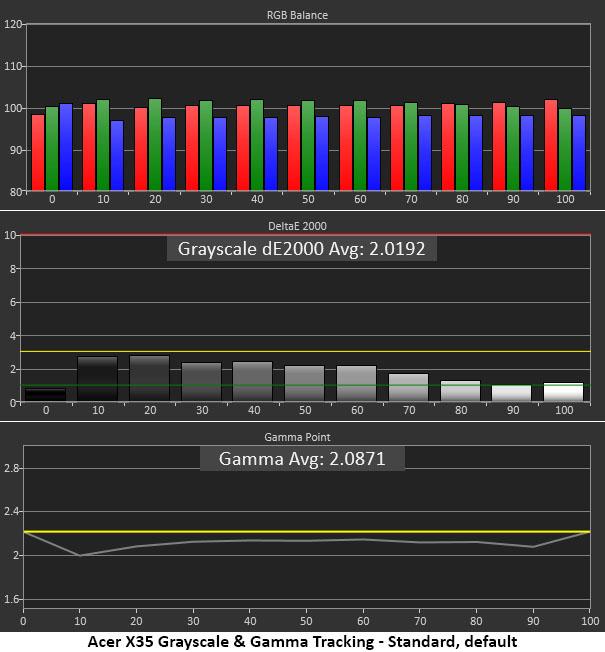
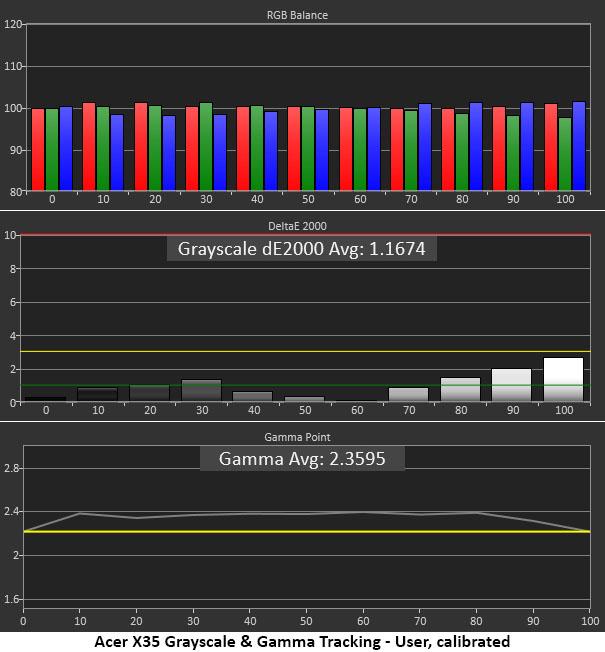
The X35 doesn't require grayscale tracking calibration because it doesn't have visible errors at any brightness level. However, gamma is a bit light. We’d rather see it on the 2.2 line rather than below. The presets are spaced wide apart, meaning we had to decide between an average value of 2.09 or 2.36. For an IPS or TN screen, we’d choose 2.09, but with higher-contrast VA panels, the higher number yields better visual results. 2.36 gave us bolder color and more image depth with deeper blacks and brighter-looking highlights.
Comparisons
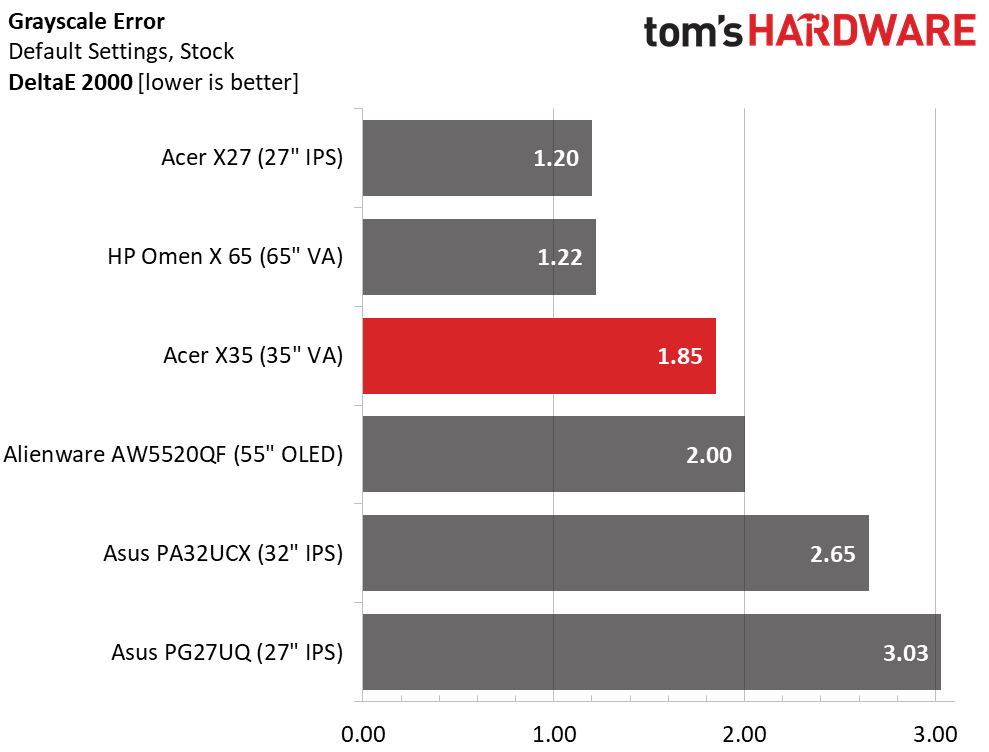
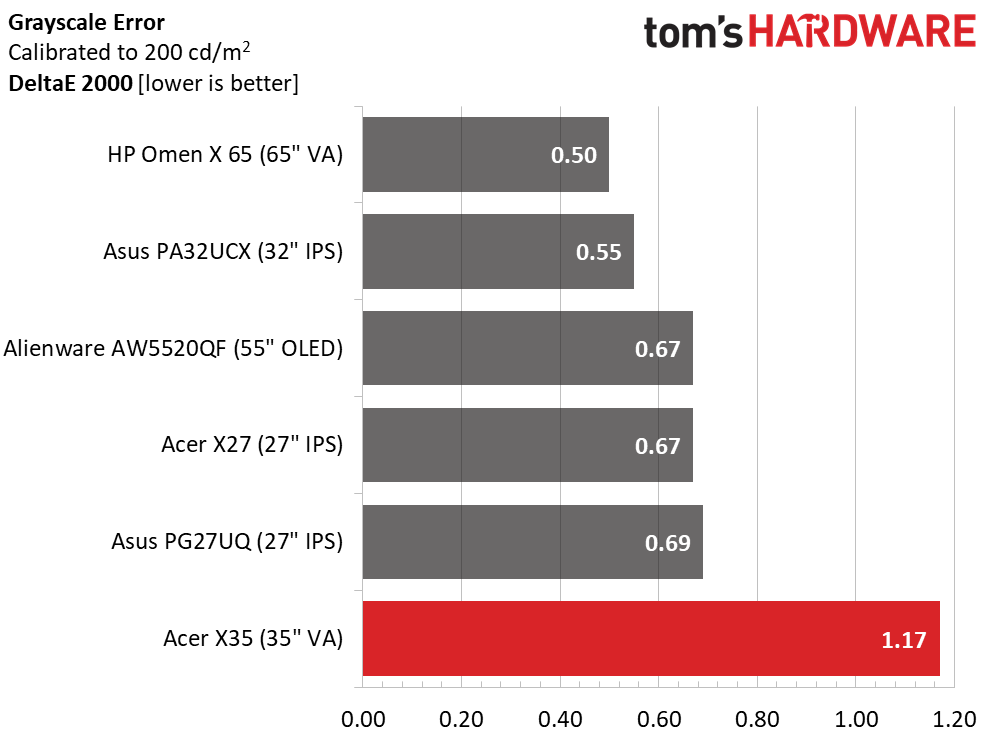
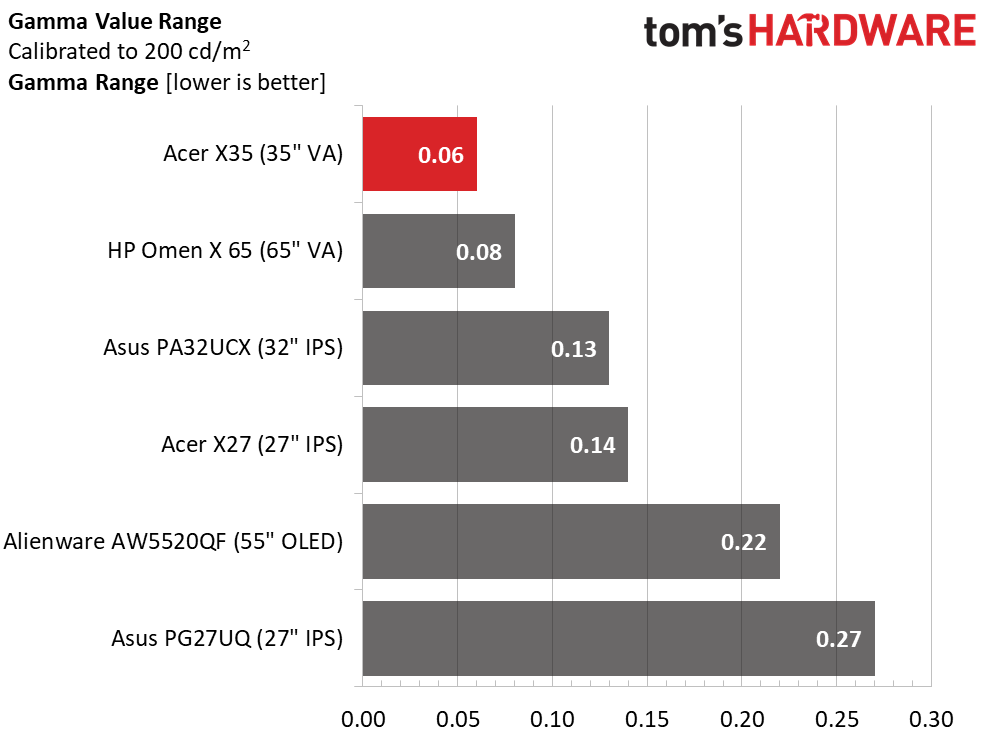
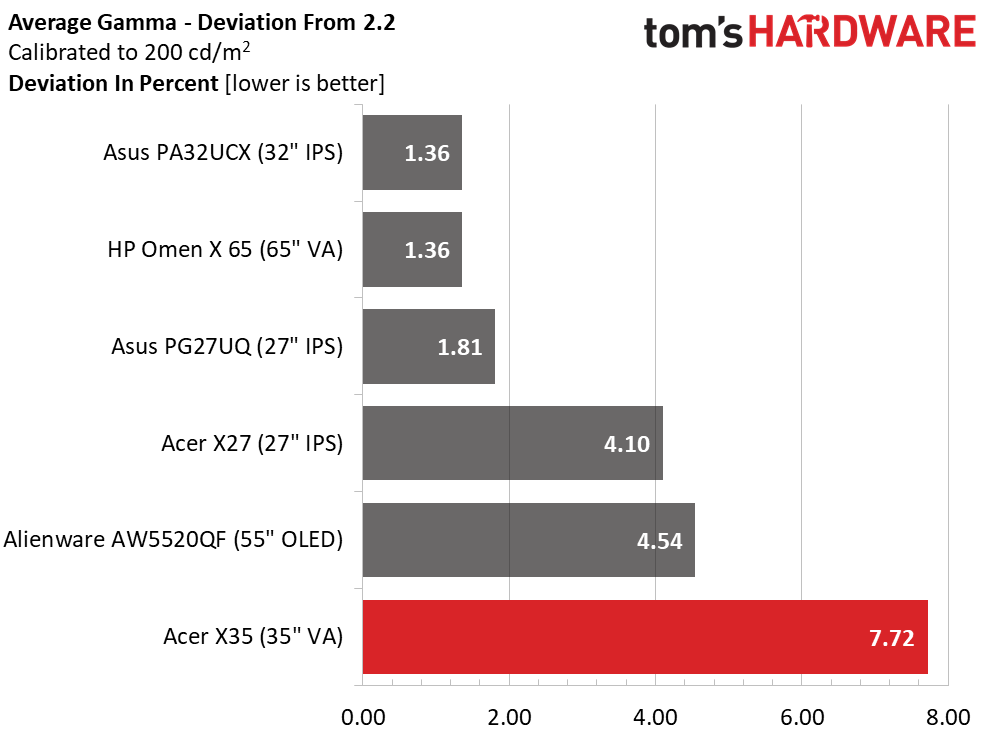
A 1.85dE average grayscale error is respectable and puts the X35 in third place among our comparison group. None of the monitors here have any significant issues out of the box. While calibration yielded a small gain, the other screens responded a little better. This is all a nit-pick though; you’d be hard-pressed to tell any of them apart once adjustments are made.
The X35 has almost perfectly linear gamma tracking with a scant 0.06 range of values. But its deviation (7.7) is greater than the other monitors here. The number in our test result would be lower (5%) had we chosen the lighter gamma option. But a 2.36 gamma looks better on a VA panel than a 2.09 one.
These are all small issues, but when you’re talking about the best computer displays in the world, hairs should be split, and nits should be picked.
Color Gamut Accuracy
For details on our color gamut testing and volume calculations, click here.
Get Tom's Hardware's best news and in-depth reviews, straight to your inbox.
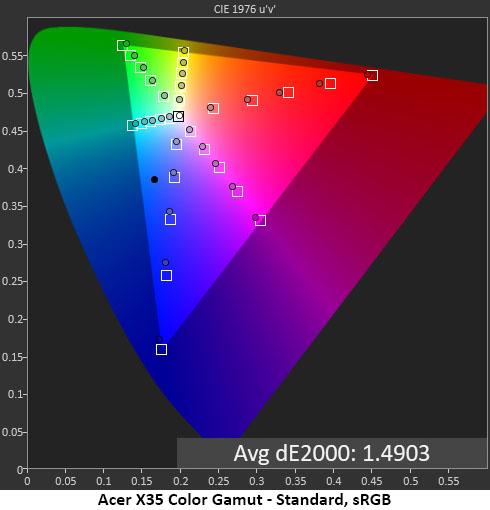
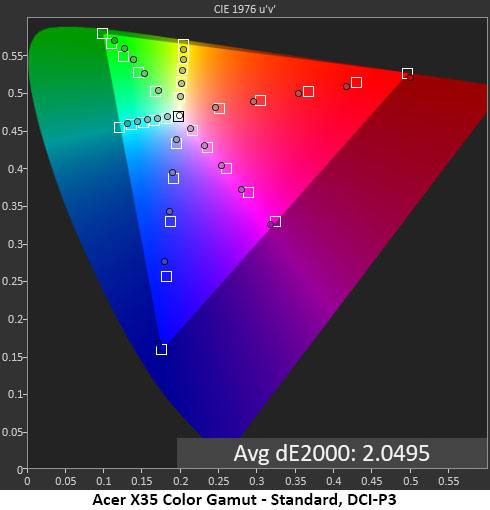
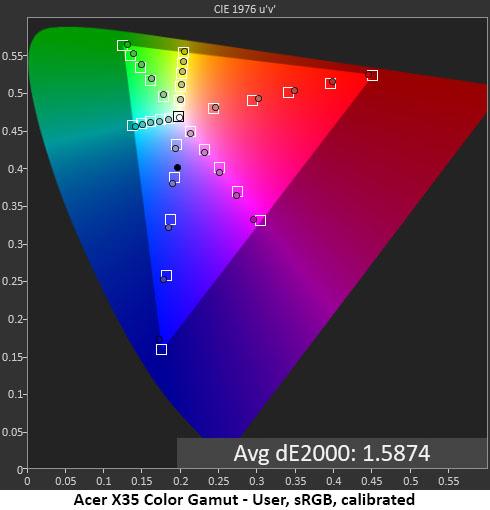
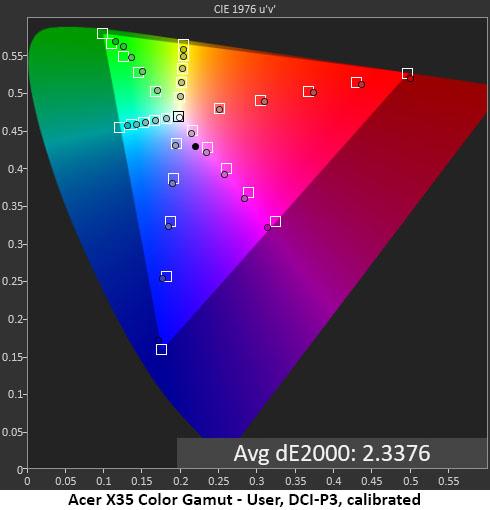
The Predator X35 is a DCI-P3 monitor with an sRGB mode, so we measured both in SDR mode. Some users will opt for the larger DCI-P3 gamut with all content for more saturated color even though it isn't completely accurate. Thanks to the light gamma, inner targets are slightly under-saturated in both gamuts. Also, DCI comes up a bit short in yellow, green and cyan but hits the 100% box for red and magenta.
Calibration (3rd chart) puts more of the saturation points on-target even though the average error increased slightly. This is due to the changes in color luminance, which aren't shown here. Either way, the X35 is extremely accurate in both gamuts and looks a little better when set to the higher gamma value.
Comparisons
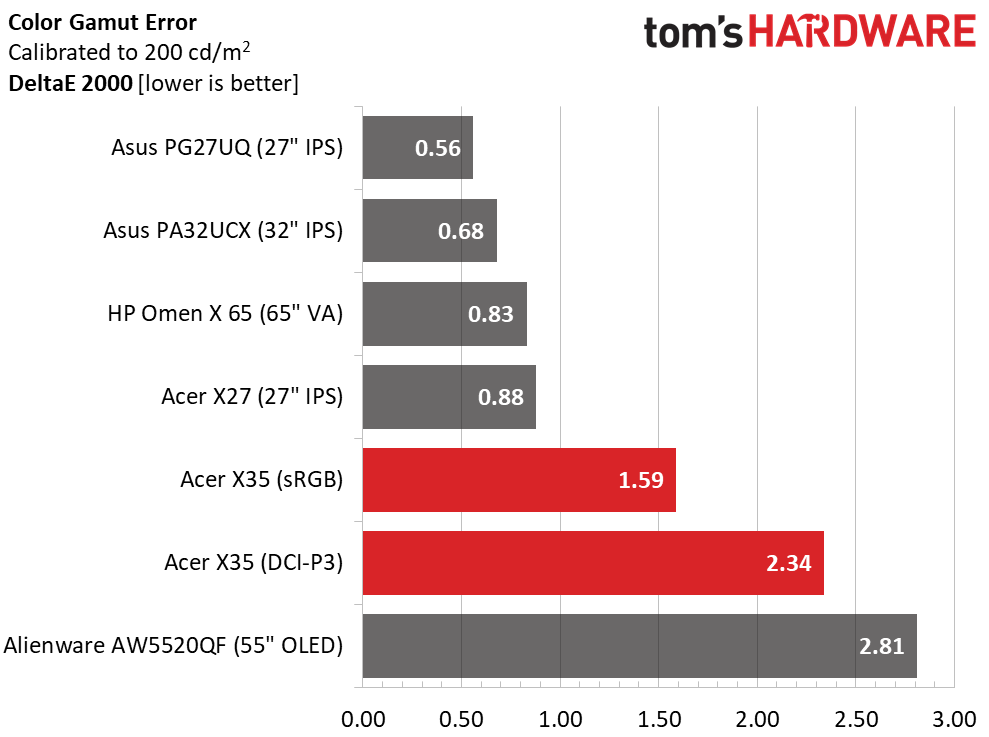
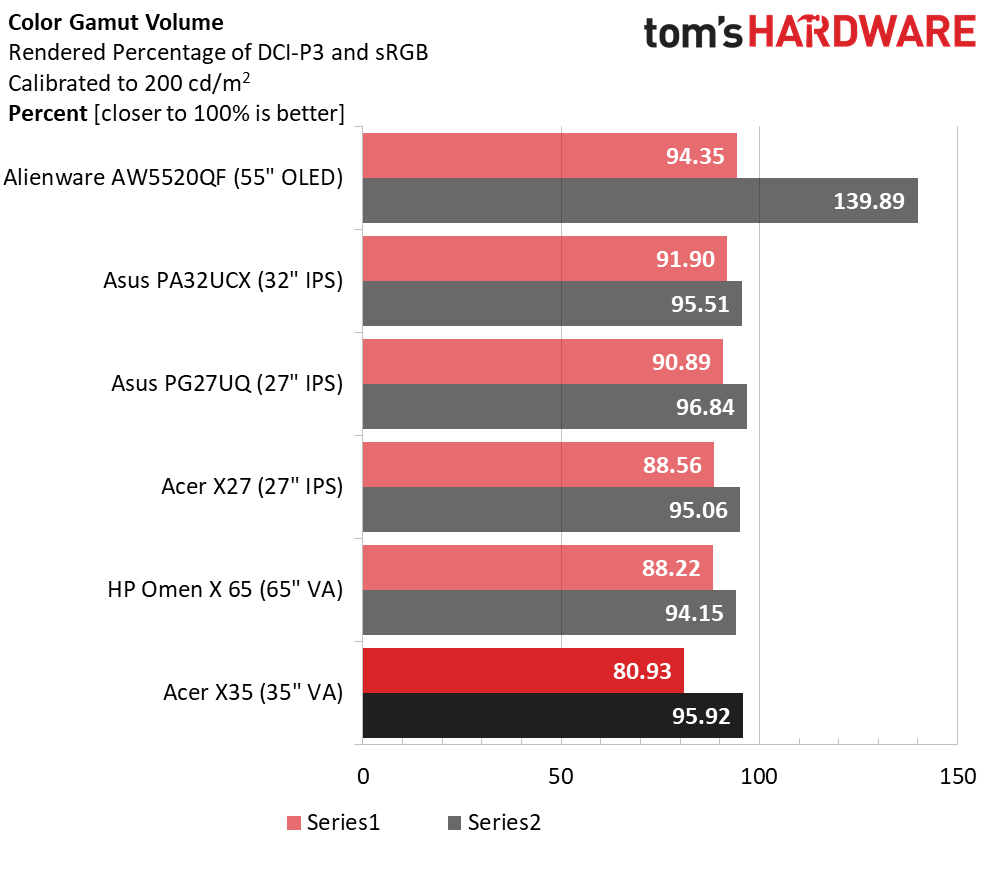
With or without calibration, the X35's color errors with both sRGB and DCI-P3 are so low with a Delta E (dE) under 3, so the average person won't be able to see them. The difference between the two gamma settings can be seen, however, so ultimately users desiring accuracy can choose either option. We like the 2.36 setting better.
Because of the under-saturation in yellow, green and cyan, DCI-P3 gamut volume is just under 81%. This is okay, but not quite as high as the other monitors in our sample group. Again, we’re splitting hairs here. sRGB misses that last 4% because green and cyan are a tiny bit under-saturated. If you want to use the X35 for color-critical work, we recommend a custom profile when editing sRGB content.
MORE: Best Gaming Monitors
MORE: How We Test Monitors
MORE: All Monitor Content
Current page: Grayscale, Gamma and Color
Prev Page Brightness and Contrast Next Page HDR Performance
Christian Eberle is a Contributing Editor for Tom's Hardware US. He's a veteran reviewer of A/V equipment, specializing in monitors. Christian began his obsession with tech when he built his first PC in 1991, a 286 running DOS 3.0 at a blazing 12MHz. In 2006, he undertook training from the Imaging Science Foundation in video calibration and testing and thus started a passion for precise imaging that persists to this day. He is also a professional musician with a degree from the New England Conservatory as a classical bassoonist which he used to good effect as a performer with the West Point Army Band from 1987 to 2013. He enjoys watching movies and listening to high-end audio in his custom-built home theater and can be seen riding trails near his home on a race-ready ICE VTX recumbent trike. Christian enjoys the endless summer in Florida where he lives with his wife and Chihuahua and plays with orchestras around the state.
-
derekullo I've never owned a curved or Ultrawide monitor.Reply
I'm sure gaming looks amazing since you can render the image so that it perfectly fits your display.
Watching a 1080p on a 4k display isn't that bad since they share the same aspect ratio and we have decent 4k upscalers.
But what about watching a 1080p movie on a 3440x1440 screen?
Do you get visual artifacts if you stretch a 16:9 to a 21:9 screen?
Do you typically watch a movie stretched out or do you create a custom 1080p resolution (basically blacks bars on the sides)? -
Late_Apex As a long time reader of this site and lurker on the forums, I am disappointed to see the rating on this monitor given the lateness of the review. I was in the market for this monitor and it’s Asus twin and very quickly realized that there is a major issue with this monitor. A quick search will reveal that there is a significant flickering problem with the backlight of this monitor during usage in some games above 60hz. Asus and Acer websites are full of complaints as are other forums.Reply
Asus to its credit posted a few weeks ago that they were working on a firmware to fix it as Nvidia is not able to do anything. Acer has been quiet on this topic.
At this point in time, at the price point, this monitor is defective and should receive a 1 star or lower rating until it is fixed appropriately. Also, Acer not even acknowledging the problem is a huge warning to stay away. -
Ninjawithagun I actually do own an Acer X35 and yes, it is provides the ultimate gaming experience. There is absolutely no substitute for HDR1000 combined with 120Hz (and higher) refresh rate, G-Sync, and 10-bit color. Regardless, gameplay on this monitor is breathtaking and something that you may have only experienced on an LG OLED TV. I will confirm the concern that Late_Apex stated regarding that there are existing issues with this particular panel. The Asus PG35VQ shares the same panel and the same issue - flickering. The flickering is triggered by specific colors and patterns within certain games. Both Acer and Asus have stated that the issue is known problem and they have a firmware solution in the works and have stated that an optional firmware update would be available by the end of December. However, it's now January and neither have provided it for download on their websites. Regardless, I still highly recommend this monitor in spite of the flickering issue. Knowing that a firmware fix will eventually be available, just makes me want to double down on my recommendation.Reply -
Ninjawithagun ReplyLate_Apex said:As a long time reader of this site and lurker on the forums, I am disappointed to see the rating on this monitor given the lateness of the review. I was in the market for this monitor and it’s Asus twin and very quickly realized that there is a major issue with this monitor. A quick search will reveal that there is a significant flickering problem with the backlight of this monitor during usage in some games above 60hz. Asus and Acer websites are full of complaints as are other forums.
Asus to its credit posted a few weeks ago that they were working on a firmware to fix it as Nvidia is not able to do anything. Acer has been quiet on this topic.
At this point in time, at the price point, this monitor is defective and should receive a 1 star or lower rating until it is fixed appropriately. Also, Acer not even acknowledging the problem is a huge warning to stay away.
Acer actually did finally respond and stated that a firmware fix is coming soon:
https://us.answers.acer.com/app/answers/detail/a_id/65552/~/acer-predator-x35-optional-firmware-update -
Late_Apex ReplyNinjawithagun said:Acer actually did finally respond and stated that a firmware fix is coming soon:
https://us.answers.acer.com/app/answers/detail/a_id/65552/~/acer-predator-x35-optional-firmware-update
That's great that they finally responded. I picked up an Asus PG27Q for the moment and have another week to return it. I've been waiting for word on the actual fix because I would like to buy the monitor in the review.
Given that this monitor came out midway through the year, the lateness of this particular review, and the known issues, I take issue with this rating. For $2000+ USD, it needs to be a 1 star monitor UNTIL it is fixed. I sent Asus an email asking for an update and no response yet as on paper, this is the best do it all monitor you can get, assuming it works as advertised!
Glad you are enjoying it. I hope the firmware will fix it for you in the near future. -
VeggieX How do you change the brightness level for the different Nit levels that they mentioned? I find the HDR too bright. I have an LG C9 that has been calibrated and my buddies CRG90 and his HDR looks much closer to my C9. It doesn't hurt my eyes.Reply
Here are the settings we used during testing:
Picture ModeUserBrightness 200 nits36Brightness 120 nits20Brightness 100 nits17Brightness 80 nits13SDR Colors sRGBOnContrast50Gamma+0.3Color Temp UserRed 97, Green 96, Blue 100